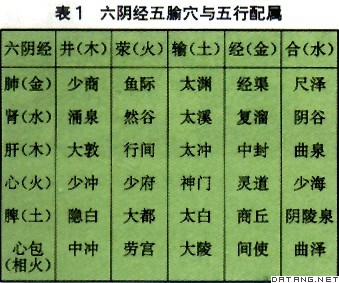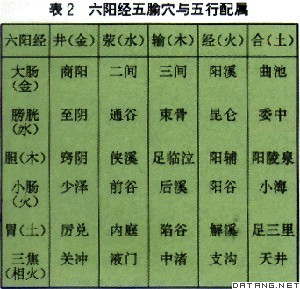1) Five Shu points


五腧穴
1.
Objective To study the structure of the Five Shu points: Shaoshang, Yuji, Jingqu, Taiyuan and Chize of the Taiyin meridian in rabbit’s forelimb.
目的 研究家兔前肢太阴经五腧穴:少商、鱼际、经渠、太渊和尺泽的层次结构。
2) acupoints


腧穴
1.
To express acupoints,《Plain Questions》 employs “shu”(俞),《pivot》 uses “shu”(输),and “shu”(腧),which have the similar usages.
《素问》用“俞” ,《灵枢》用“输”与“腧”表示腧穴 ,三字用法基本相同。
2.
From the acupoint that is visualization of functional brain imaging of acupuncturing effects , fMRI technology is adopted to acupuncture in acupoints ( QUECHI, HEGU and ZUSANLI) that are usually chosen in cerebral stroke, and the differences among different brain cortical activation are compared.
本文采用fMRI技术,从腧穴针刺效应的脑功能成像可视化角度,选择脑中风常用穴曲池、合谷、足三里进行针刺,比较各自脑激活区反应的差异,旨在明确腧穴、穴组与脑皮层兴奋的相关性,为针灸临床选穴提供基于fMRI技术的实验理论依据。
3.
Acupoints compatibility is the key to acupuncture prescription,directly related to the therapeutic effect.
腧穴的配伍是针灸处方的关键,直接关系到治疗效果。
3) Acupoint


腧穴
1.
Analysis on the research methods of acupoint speciality;


浅析腧穴特异性的研究思路
2.
Morphological Evidence of Some Prohibit-Needling Acupoints in Ancient Acupuncture Books;


简析古代医籍中禁针慎针腧穴的形态学依据
3.
Analysis of Nature of Acupoint with Studying Canon of Internal Medicine


读《内经》探析腧穴本质
4) points
[英][pwæ~t] [美][pwɑnt]


腧穴
1.
Meridian Acupoints′ Selection in Acupuncture Treatment for Migraine:The Main Characters and Relevant Factors Analysis
十四经腧穴在偏头痛治疗中的运用特点及相关因素分析
2.
Model Study Between Meridian Acupoints and Anatomical of Relations


经络腧穴与解剖学关系的模型研究
3.
Objective: To sum up the data about the indication of the points of Stomach Meridian of Foot-Yangming in ancient and modern literature and calculate the indication frequency to conclude the high-frequency indication of the points of Stomach Meridian of Foot-Yangming.
目的:归纳古代文献与现代文献中有关足阳明胃经各腧穴的相关论述,统计主治症频次,总结足阳明胃经各腧穴的高频次主治症。
5) Point anatomy


腧穴解剖
补充资料:五腧穴
| 五腧穴 十二经脉在四肢肘膝关节以下五个重要腧穴的总称,分别名为井穴、荥穴、输穴、经穴、合穴。合称五腧。 古人用自然界的水流状态比喻经气运行的过程,把五腧穴按井、荥、输、经、合的顺序,从四肢末端向肘、膝方向依次排列。经气的流注亦由小到大,由浅入深。井穴多位于手足之端,喻作水之源头,是经气所出的部位,即“所出为井”。荥穴多位于掌指或跖趾关节之前,喻作水流尚微,未成大流,是经气流行的部位,即“所溜为荥”。输穴多位于掌指或跖趾关节之后,喻作水流由小而大,由浅注深,由此注彼的部位,即“所注为输”。经穴多位于腕踝关节以上,喻作水流变大,经气运行畅通,即“所行为经”。合穴位于肘膝关节附近,喻作江河水流汇入湖海,是经气由此深入,进而会合于脏腑的部位,即“所入为合”。 五腧穴又配属五行,《灵枢·本输》指出阴经的井穴属木,阳经的井穴属金。《难经》补全了阴阳各经脉五腧穴的五行属性。十二经脉各有五输穴,共60个(表1、表2)。
五腧穴是常用要穴,为历代医家所重视。临床上“井主心下满”,井穴可用于治疗神志昏迷;“荥主身热”,荥穴可用于治疗热病;输主体重节痛,输穴治疗关节痛;“经主喘咳寒热”,经穴治疗喘咳;“合主气逆而泄”,合穴治疗六腑病证等。另外,按阴阳相合、刚柔相济的关系,将阴井乙木与阳井庚金配合起来,成为子午流注针法按时取穴及合日互用开穴规律的理论基础。 |
说明:补充资料仅用于学习参考,请勿用于其它任何用途。
参考词条

